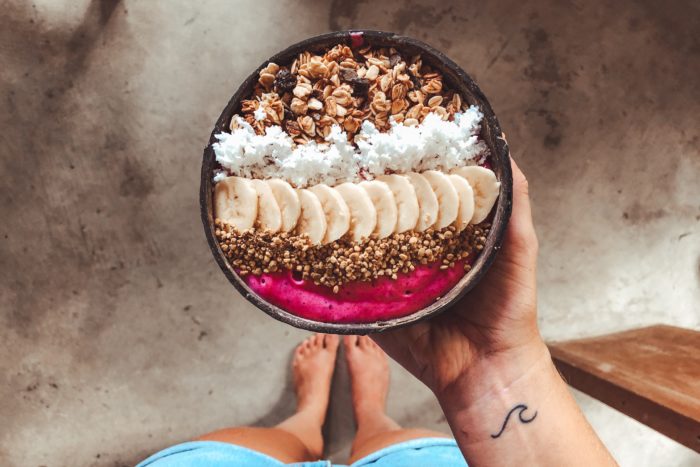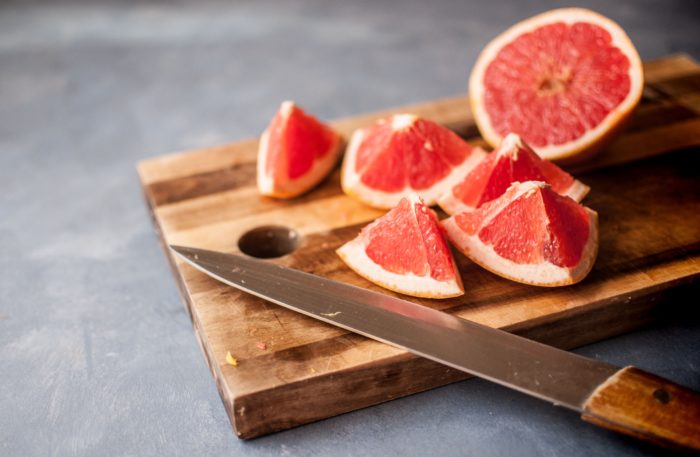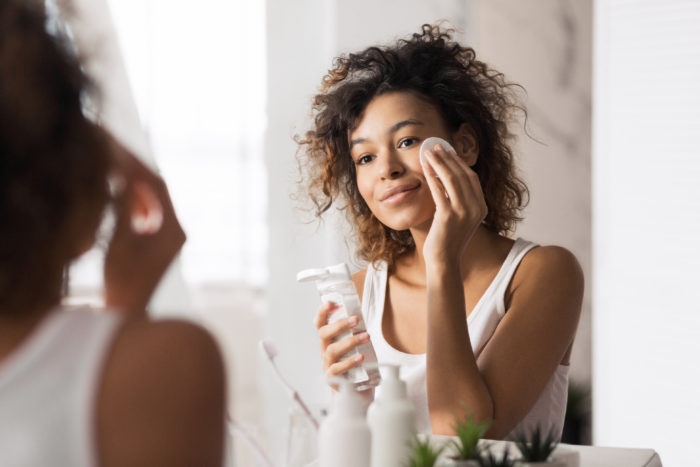This post may contain affiliate links.
Whether your estrogen is too high or too low, you can work on balancing it with some simple diet and lifestyle changes. Keep reading to learn how!
Hormone imbalance is a common issue for many women. Especially women who are used to training at a high level and strictly controlling their diet.
But, when our hormone levels get out of whack, we can experience a variety of unpleasant health issues.
Dealing with high estrogen can result in symptoms like mood swings, weight gain, breast tenderness, acne, and irregular periods. And low estrogen can cause hot flashes, missing periods, headaches, and fatigue.
Our estrogen levels can become unbalanced from a variety of factors. Things like a poor diet, certain medications, and environmental stressors are among the most common causes of estrogen imbalance.
Fortunately, balancing your hormone levels doesn’t have to be complicated. Oftentimes, simple diet and lifestyle strategies are all you need to get back on track.
In this blog post you’ll learn:
- The common causes of estrogen imbalance
- Simple dietary strategies to rebalance estrogen
- Some lifestyle changes you can make to encourage healthy hormones
Keep reading if you’re ready to learn how to balance your estrogen using simple diet and lifestyle techniques!

How Estrogen is Regulated
Before we dive into how to balance estrogen with diet and lifestyle changes, let’s take a look at how estrogen is regulated in the body.
Our sex hormones, like estrogen, are constantly being produced. This means that they also need to be continuously excreted and removed from the body. If not, they’ll build up and there will be too much of those hormones floating around.
The liver is our main organ that facilitates hormone and toxin excretion. That means your liver controls the excretion of excess estrogen.
First, the liver conjugates estrogen using detoxification enzymes and then secretes them with the bile into the small intestine through the gallbladder.
Estrogen, along with other compounds, is mostly reabsorbed in the small intestine and ultimately eliminated by the kidneys. Some of the compounds are then excreted in the stool, depending on how well they are reabsorbed in the small intestine.
The fewer hormones that get reabsorbed, the more that will be excreted in the stool, and thus eliminated from the body.
But sometimes this absorption and excretion process doesn’t work as efficiently, and this excess estrogen hangs around in our bodies when we no longer need it. This can result in symptoms of “estrogen dominance” – which is actually just high estrogen compared to other hormones – and can affect our hormonal and overall well being.

Common Causes of Estrogen Imbalance
Estrogen imbalance is a more common condition than many women realize.
Our hormones exist in an extremely delicate balance. And when that balance gets thrown off – even slightly – it can cause a cascade of both hormonal and non-hormonal health concerns.
We certainly can’t control all of the external factors that can result in hormonal imbalance. But by being aware of the most common factors, we can minimize what we can to keep our hormones healthy.
Here’s a quick overview of some common causes of estrogen imbalance:
- Hormonal Birth Control – most HBC pills contain synthetic estrogens and progesterone. These pills work by suppressing our body’s natural hormone production and replacing it with an influx of synthetic hormones. Even after just a few months of use, HBC can cause dramatic hormonal imbalances that can exist long after you’ve stopped using the pill.
- Personal Care Products – common ingredients in many personal care products like Parabens, Phthalates, and Benzophenones are known endocrine disruptors. Using these items on your skin each day can play a contributing factor in your hormone imbalances over time.
- Digestive Issues – our gut houses a group of bacteria that helps to metabolize and remove estrogen. When your gut is sluggish or you have an imbalance in your gut bacteria, the estrogen your body is producing doesn’t get removed as efficiently and can start to build up and recirculate, causing hormonal imbalance.
Now that we’re aware of some of the most common causes of estrogen imbalance, let’s dive into the best ways you can balance estrogen naturally!

Diet for Balancing Estrogen
Our diet can have a big impact on how well our body metabolizes and successfully eliminates estrogen.
Most of our estrogen gets eliminated through our digestive tract. And when our gut is working well, helped along by a gut-healthy diet, having balanced estrogen levels is so much easier.
Here are some simple diet tweaks that can help you improve your estrogen balance.

Eat More Fiber
A high fiber diet may help lower estrogen and testosterone.
Our hormones, like estrogen and testosterone, are cholesterol-based. This means that when our body is finished with them, they’re secreted into the gut along with the bile produced by the liver.
These hormones can then be bound to soluble fiber in the gut and excreted in the stool.
There is controversy about how much of these bile contents can bind with fiber. But there is likely some amount of binding which prevents some reabsorption of cholesterol-based compounds back into the blood.
Therefore, increasing your fiber intake may be helpful for reducing excess estrogen.
Soluble fiber specifically binds with cholesterol excreted in the bile. So, if you’re looking to help bind and excrete those excess hormones, that’s the type of fiber you should focus on increasing in your diet.
Citrus fruits like oranges and grapefruit have some of the highest levels of soluble fiber, along with berries, apples, apricots, dates, prunes, mango, and pears.
Starchy vegetables like sweet potatoes, white potatoes, carrots, turnips, and other root vegetables are also high in soluble fiber.
Non-starchy vegetables with a high amount of soluble fiber include asparagus, brussels sprouts, squash, zucchini, and broccoli. If you eat legumes or peas, lentils, chickpeas, and pinto beans also have a high amount of soluble fiber.
Aim for about 25 grams per day of soluble and insoluble fiber as tolerated (Note: if you have a digestive condition, you may need to eat less fiber.)
Supplementing with Soluble Fiber
Supplemental soluble fiber like oat bran, flaxseeds, psyllium husks, and methylcellulose are commonly used as easy ways to greatly increase fiber intake. But overdoing fiber supplementation can cause gas or stomach cramping, and can also bind to nutrients and prevent absorption of vitamins or minerals in your food, including iron, zinc, calcium, and magnesium.
I would suggest that fiber supplements be a last resort and that you should try to get your fiber from plant foods in your diet.
If you want to try using soluble fiber supplements, make sure you start slow and choose supplements that are gluten-free. I would also recommend taking them first thing in the morning and on an empty stomach, so you’re not binding up nutrients from your food.
Fiber supplements can also affect the action of certain medications, so check with your doctor if you’re taking any prescription drugs.
If you plan to take any of these supplements, it’s crucial that you significantly increase your fluid intake, since these high-fiber containing supplements absorb a great deal of water in your gut.

Stimulate Bile Production
Another way to balance estrogen using diet is to use foods that stimulate bile production. This can help increase the excretion of excess cholesterol-based hormones.
Olive oil is one of the best oils for stimulating bile production and can be easily added to salads and cooked vegetables.
Drinking warm water with fresh lemon in the morning can also help stimulate bile production, and works best on an empty stomach. Artichokes, beet greens, and bitter lettuces are choleretics, which means they help increase the production of bile.
Sauerkraut and sauerkraut juice helps stimulate bile production as well, and also contains sulfur, DIM, and soluble fiber. Sauerkraut and other fermented foods are some of the best foods to eat if trying to reduce estrogen levels.
There are a few choleretic herbs used to support liver function and increase bile production, such as green tea, milk thistle, artichoke extract, and turmeric. I recommend working with an experienced practitioner before experimenting with supplements or herbs.

Eat More Carbs
Believe it or not, a diet too low in carbohydrates is one of the most common culprits for estrogen imbalances.
When carb consumption is too low it can suppress your leptin levels. Leptin is the hormone that regulates your appetite. And when your leptin levels are in the tank, you can experience symptoms like a missing period and general hormonal imbalance.
Diets too low in carbohydrates can also result in an increase in the stress hormone cortisol. This disruption of the HPA-axis can cause a hormonal imbalance cascade that can impact all areas of your health.
In order to avoid these hormonal disruptions and better balance your estrogen levels, make sure that your diet contains plenty of real-food sources of carbs.
Generally, I recommend about 30-50% of your total calories come from carbohydrates if you are a premenopausal woman.
If you’re eating about 2,000 calories a day, this comes out to around 150-250 grams of carbs.
And if this seems like a lot, you’re not alone in thinking that. Many women eating a real food or Paleo diet aren’t even close to meeting this carb intake minimum.
But being intentional about your carb intake and ramping it up slowly is the best way to help rebalance your hormones, naturally.

Lifestyle for Balancing Estrogen
Diet isn’t the only change you need to make to successfully balance your estrogen levels.
Your lifestyle plays a huge role in your hormonal health. In some cases, it can truly be a more important factor than diet.
Here are some of the best ways you can use your lifestyle to help balance your hormones.

Support Your Liver
The liver is the main organ that regulates the amount of hormones in our body. So supporting your liver is very important for managing hormonal issues.
The liver uses methylation and sulfation to conjugate excess estrogens for excretion. (Those are big words for packaging up those estrogens so they can be easily transported out of your body.)
Eating foods that support those processes, specifically foods that supply methyl and sulfur groups can help with estrogen regulation.
Vitamin B6, folate, and vitamin B12 supply methyl groups, and sulfur-containing foods include egg yolks, garlic, onions, brussels sprouts, and cabbage.
Diindolylmethane (DIM) is often used to help the liver detoxify excess estrogen. But if you prefer not to take supplements, you can get DIM in your diet by eating cruciferous vegetables such as broccoli, Brussels sprouts, cabbage, and kale.
Be sure to cook these crucifers thoroughly, especially if you have hypothyroidism.
Calcium-D-glucarate is another supplement that supports liver detoxification pathways and is also found in a variety of fruits and vegetables.

Avoid Xenoestrogens
Avoiding xenoestrogens, or chemical estrogen-like compounds found in the environment is crucial for hormonal balance.
These include non-organic fruits and vegetables (particularly those on the Dirty Dozen list), conventional meat and dairy products, cosmetic chemicals including parabens and phthalates, plastics containing BPA, Teflon-coated pans, cleaning products that use petrochemicals, and chemical deodorizers like dryer sheets and air fresheners.
To further avoid xenoestrogens, avoid microwaving your food in plastic – instead, use glass or ceramic. Store leftovers in glass containers and avoid direct contact of food with plastic wrap. I know this sounds excessive, and it’s difficult to 100% avoid these in our modern environment, but every change counts!
Start slow, and don’t get overwhelmed (see my next lifestyle tip!) Perhaps you just change to a BPA-free water bottle and throw out your Teflon-coated pans. Or change to a chemical-free beauty routine. Every little bit helps, so make one change at a time if you’re overwhelmed.

Reduce Stress
The physical and mental effects of stress can have a pretty powerful impact on our health. And our delicate hormone balance is not immune to those effects.
When we’re stressed, either from too many intense training sessions or a deadline at work, our stress hormone cortisol skyrockets.
And when our cortisol is elevated, our body goes into what’s known as a “fight-or-flight” response. Essentially, our body downregulates other non-essential processes, like our estrogen production, so it can have more resources available for dealing with the stressor.
This is a great automatic mechanism if you’re running away from a tiger. But, in our modern society, where stress is no longer acute and life-threatening but tends to be chronic, this response can be damaging to our overall health.
Working to manage your mental and physical stressors will do wonders for balancing your hormones.
Decreasing your stress can look like learning to say “no” to commitments that would overburden you. Or you might need to tone down your training routine to just a few days.
Whatever managing your stress looks like for you, the more improvements you make in this area, the faster you’re likely to see corresponding improvements in your hormonal health.

The Bottom Line on Balancing Estrogen Naturally
Balancing estrogen levels naturally doesn’t have to be an extra “to-do” on your already full list.
Most of these diet and lifestyle adjustments are what I would recommend for any woman looking to improve their general health and wellbeing.
There are some targeted approaches we can take to balance estrogen, specifically. But implementing these changes will help improve not only your hormone balance but your overall health as well.
Have you had any success with changing your diet and reducing excess estrogen? Please share your story in the comments below!

+ show Comments
- Hide Comments
add a comment